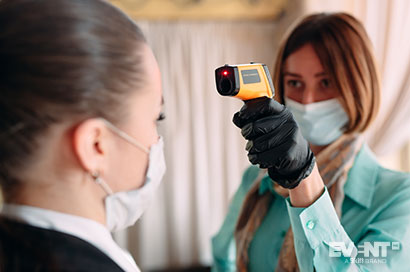Skift Take
Thermal testing to screen people for a Covid-19 infection has been employed by many large companies to scan their employees before they enter the building. Could it be the answer to event organizers’ prayers or is it just a placebo safety measure?
Thermal screening was the first-line defence at airports and other entry-points to determine whether a person could be infected with the coronavirus. Large companies are still implementing it, colleges and schools are considering it when they reopen, and there is a lot of discussion about how it could help bring live events back faster.
But there is little proof it works to determine if somebody is actually infected and at risk of spreading the disease. Could it just be a placebo measure?
Thermal Screening Options in Use Now
Thermal screening or testing is usually done using either a temporal probe or a thermal camera.
A fever is one of the symptoms most reported for Covid-19 infections, so it seems logical to check people’s temperature to see if they might be infected.
Businesses like Amazon have implemented daily thermometer checks in their warehouses. Meanwhile, everybody who comes into MLK Jr. Community Hospital in Los Angeles has their body temperature checked by thermal camera. They were using temporal probes before, but the camera is much faster as it provides instantaneous results. Temporal probes also don’t allow for a safe distance between the operator and the subject, and require more manpower than thermal imaging devices.
Thermal Screening for Events
There are currently discussions to extend thermal testing to large events. In most stadiums, for example, people are already screened through metal detectors and sometimes have their bags checked. Adding a thermal camera to the process would be a marginal increase in the inconvenience event-goers experience.
However, there are a number of factors that complicate the reliability of thermal testing. For one thing, all kinds of things can raise your body temperature, from exercise to stress to, obviously, other illnesses. Moreover, the accuracy of thermal screening has come under scrutiny with the revelation that people can be completely asymptomatic and still spread the virus to others.
Using temperature-based testing could, on the one hand, exclude people who do not have the coronavirus and, on the other, provide a false sense of security to those that do.
Finally, measuring temperature from a distance is not as accurate as measuring it in the ear, and this is a concern if thermal cameras are going to be widely used to grant access to a building or event. Relying solely on temperature as an indicator of infection by Covid-19 can, therefore, prove misleading, and you will likely need secondary measurements to confirm the infection diagnosis. This takes time and manpower, and could possibly burden healthcare services unnecessarily.
Is There Anything Else Out There?
A new laser testing technology developed in the UAE could be the answer. The technique promises to instantaneously detect the coronavirus within infected blood as soon as an infection takes hold. This makes it quite promising as a detection method at scale.
“Our laser-based DPI (diffractive phase interferometry) technique, based on optical-phase modulation, is able to give a signature of infection within a few seconds. What’s more, it is user-friendly, non-invasive, and low-cost. The device is suitable for use not only in hospitals and public places like cinemas and shopping malls but with a ‘little hands-on training’ it can be used for in-house testing and monitoring. We believe it will be a game-changer in tackling the spread of the coronavirus.”
– Dr. Pramod Kumar, Lead Doctor and Principle Scientist, QuantLase Imaging Laboratory
The diagnostic system uses artificial intelligence to analyze a massive number of images accurately and efficiently, which is critical whenever you need to apply technology on a large scale.
The product could be rolled out in just a few months, providing a more accurate alternative to thermal screening.
IN CONCLUSION
Considering the uncertainty surrounding large-scale events in the near future, it may be prudent for event organizers and venues to hold off on investing in thermal screening. An affordable, scalable solution might be only a few months away with DPI.
However, now is the time to begin asking yourself about the logistics of implementing it, strategies for communicating about it, and of course, data and privacy implications. That way, you’ll be ready to avail of the solution as soon as it becomes available for your event.





